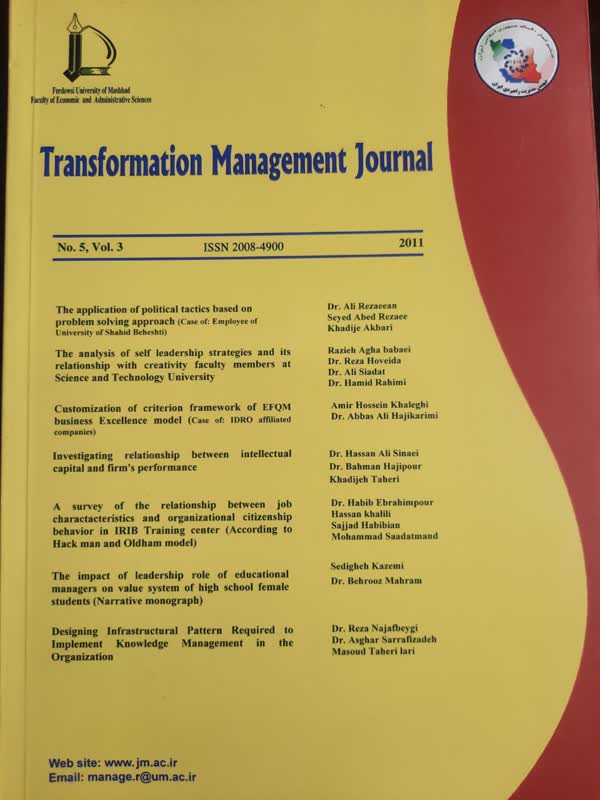Document Type : Articles
Author
Abstract
Resource based view suggests that superior firm performance can derive from uniqueness of resources reconfiguration and integration of existing resources and/or from the ability to respond appropriately to the surrounding industrial environment. Based on this view, performance differs from one firm to another since successful organizations may have access to more strategic resources (physical, human, organizational) than their competitors. Such differences are likely to play an important role in business success in terms of profitability. One of The firm's resources is intellectual capital that incorporates innovation capital and customer capital. This study investigates relationship between innovation capital and customer capital with financial performance and their complementary interactions with firm performance within their existing technology. Data was collected from 1381- 1386 performance of manufacturing firms provided by Tehran Stock Exchange. Pearson correlation technique was utilized to analyze Research data that was collected from 52 manufacturing firms of which 26 were known as high technology and 26 of low technology firms. The result showed that: both variables (innovation and customer capital) significantly and positively related to financial performance. Moreover, the strength of the relationship between innovation capital and performance in the high technology firms did not indicate any significant difference to that of low technology firms.
Keywords
- Bontis, N. (2002). “National intellectual capital index: the benchmarking of arab countries”, Journal of Intellectual Capital, 14(4), 25–45.
- Chang, Chun-Jung. (2004). The study of relationships among intellectual capital, Business performance and business value for the biotechnology industry in Taiwan, Master's thesis, graduate institute of accounting, http://ethesys.lib.fcu.edu.tw/ETD-search/view_etd?URN=etd-0628105-154505.
- Chen, Yu-Shan. (2008). “The positive effect of green intellectual capital on competitive advantages of firms”, Journal of Business Ethics, 77, 271–286.
- Chin, Chen-Lung., Lee, Picheng, Kleinman, Gary & Chen, Pei-Yu. (2006). “IPO anomalies and innovation capital”, Rev Quant Finan Acc, 27, 67–91.
- Dhanani, Sangeet. , O’Shaughnessy, Nicholas, & Louw Eric. (1997). “Marketing practices of UK high technology firms”, Logistics information management, 10 (4), 160–166.
- Dutta, S & Narasimhan, Orajiva, S. (1999). “Success in high technology markets: is marketing capability critical?” Marketing Science, 18(4), 574-568.
- Fang, Yen-Chin. (2006). Human capital accumulation, innovation, and firm Performance. Master's thesis, available at: http://thesis.lib.ncu.edu.tw/ETD-db/ETD-search/view_etd?URN=93427003.
- Ghlichli, B., & Moshabaki, a. (2006). “The role of social capital in intellectual capital”, Journal of Knowledge Management, 19(57), 125-147. (in persian).
- Grindley, P., & Teece, C. (1997). “Managing intellectual capital: licencing and cross- licencing in semiconductors and electronic”, California Management Review, 39 (2), 8-42.
- He, J., & Nie S. (2008). “The impact of innovation and competitive intensity on positional advantage and firm performance”, The Journal of American Academy of Business Cambridge, 14 (1), 205- 214.
- Kotler, P., & Armstrong. G. (2004). Principales of marketing, (Fifth ed) Tehran: bahman Frouzandeh, atropot. (in persian)
- Lahtinen, K. (2007). “Linking resource-based view with business economics of woodworking industry: earlier findings and future insights”, Silva fennica,
41(1), 411- 422.
- Lee, J. & Giorgis, Habte-Berhe. (2004). Empirical approachto the sequential relationships between firm strategy, export activity, and performance in U.S. manufacturing firms”, International Business Review, 13, 101–129
- Louis, Y & chyan, Y. (2004). “The R&D and marketing coopration across new product development stage:an empirical study of Taiwan IT industry”, Industrial Marketing Management, 33(7), 593-605.
- Luo Xueming., Griffith, David A., Liu Sandra S. & Shi Yi, Zheng. (2004). “The effects of customer relationships and social capital on firm performance: A Chinese Business Illustration”, Journal of International Marketing, 12(4), 25–
45.
- McAlister, Leigh. Srinivasa, Raji. & Kim, MinChung. (2007). “Advertising, research and development, and systematic risk of the firm”, Journal of Marketing, 71, 35–48.
- Nasiriyar, m. (2006). “The three view in strategic management”, Journal of Tadbir, 17(17), 54- 68. (in Persian)
- Nazari, Jamal A. & Herremans, Irene M. (2007). “Extended VAIC model: measuring intellectual capital components”, Journal of Intellectual Capital, 8(4), 595-609.
- Newbert, S. L. (2007). “Emperical research on the resourse-based view of the firm: an assessment and suggestions for future research”, Strategic Management Journal. 28, 121–146.
- Neveu, R. (2002). Fundumentals of managerial finanace, (seventh ed), Tehran: Ali Jahankhani & Ali Parsayian, SAMT (in Persian).
- O’Brien, L. & Jones, C. (1995). “Do rewards really create loyalty?” Harvard Business Review, 73(3), 75–83.
- Ramaswami, Sridhar N. & Srivastava, Rajendra K. (2009). “Market-based capabilities and financial performance of firms: insights into marketing’s contribution to firm value”, Academy of Marketing Science, 37(2), 97-116
- Plessis, Marina du. (2007). “The role of knowledge management in Innovation”, Jornal of Knowledge Management, 11(4), 20-29,
- Sharma, varinder M & Erramilli, M Krishna. (2004). “Resource-based explanation of entry mode choice”, Journal of Marketing Theory and Practice, 12(1), 1-18.
- Sher, Peter J & Yang, Phil Y. (2005). “The effects of innovative capabilities and R&D clustering on firm performance: the evidence of Taiwan’s semiconductor industry”, Technovation, 25, 33–43.
- Smith, K. (2007). Innovation, growth and policy in low and medium tech industry, Australian innovation research centre, Australia.
- Thornhill, S. (2006). “Knowledge, innovation and firm performance in high- and low-technology regimes”, Journal of Business Venturing , 21, 687– 703.
- Tsai, Kuen-Hung., Chou, C. & Chen, Ming-Yi. (2008). “Does matching pay policy with innovation strategy really improve firm performance? An examination of technology-based service firms”, Personnel Review, 37(3), 121-134.
- Tseng, Shu-Hui. (2006). “The relationship between human capital, innovation capital and organizational performance”, Master's Thesis, Executive Master of Human Resource Management. http://thesis.lib.ncu.edu.tw/ETD-db/ETD
search/view_etd?URN=944307008.
- Wang, Wen-Ying & Chang, C. (2005). “Intellectual capital and performance in causal models Evidence from the information technology industry in Taiwan”, Journal of Intellectual Capital, 6(2), 222-236.

Send comment about this article